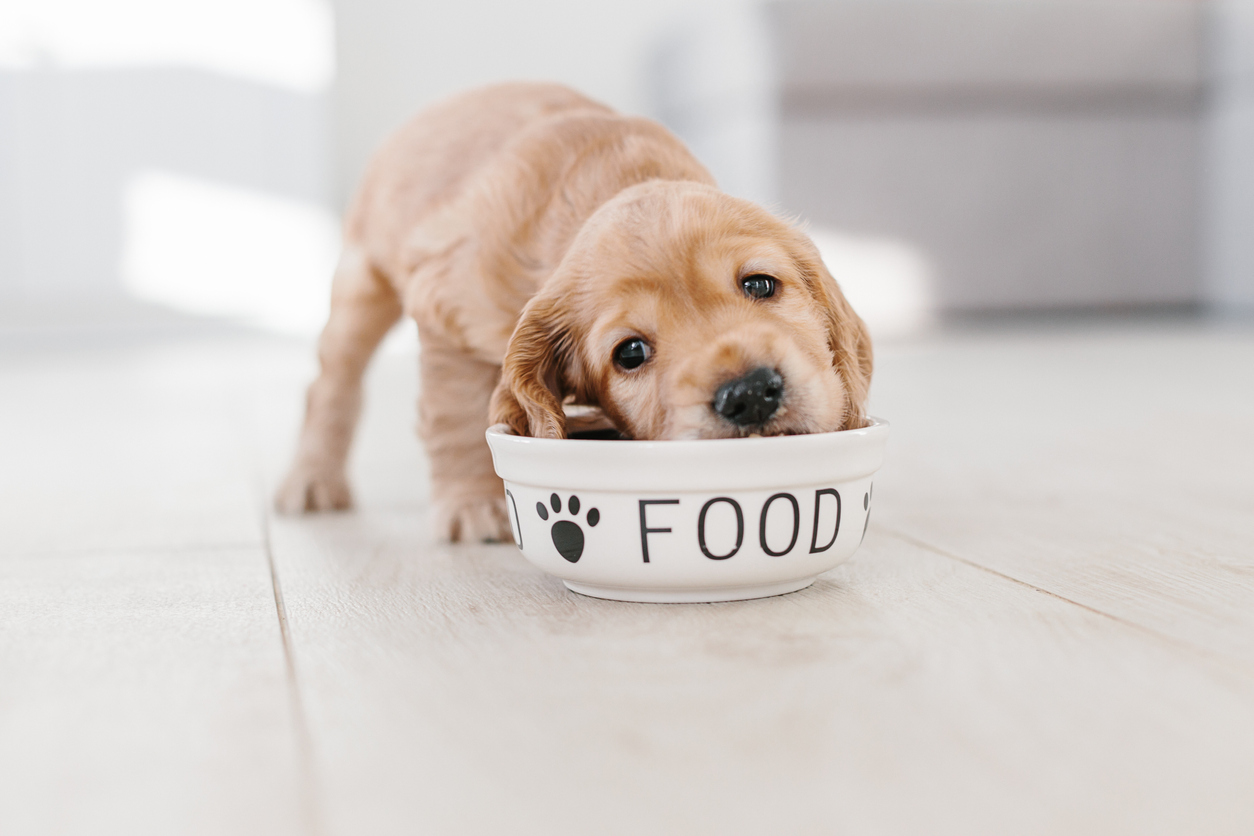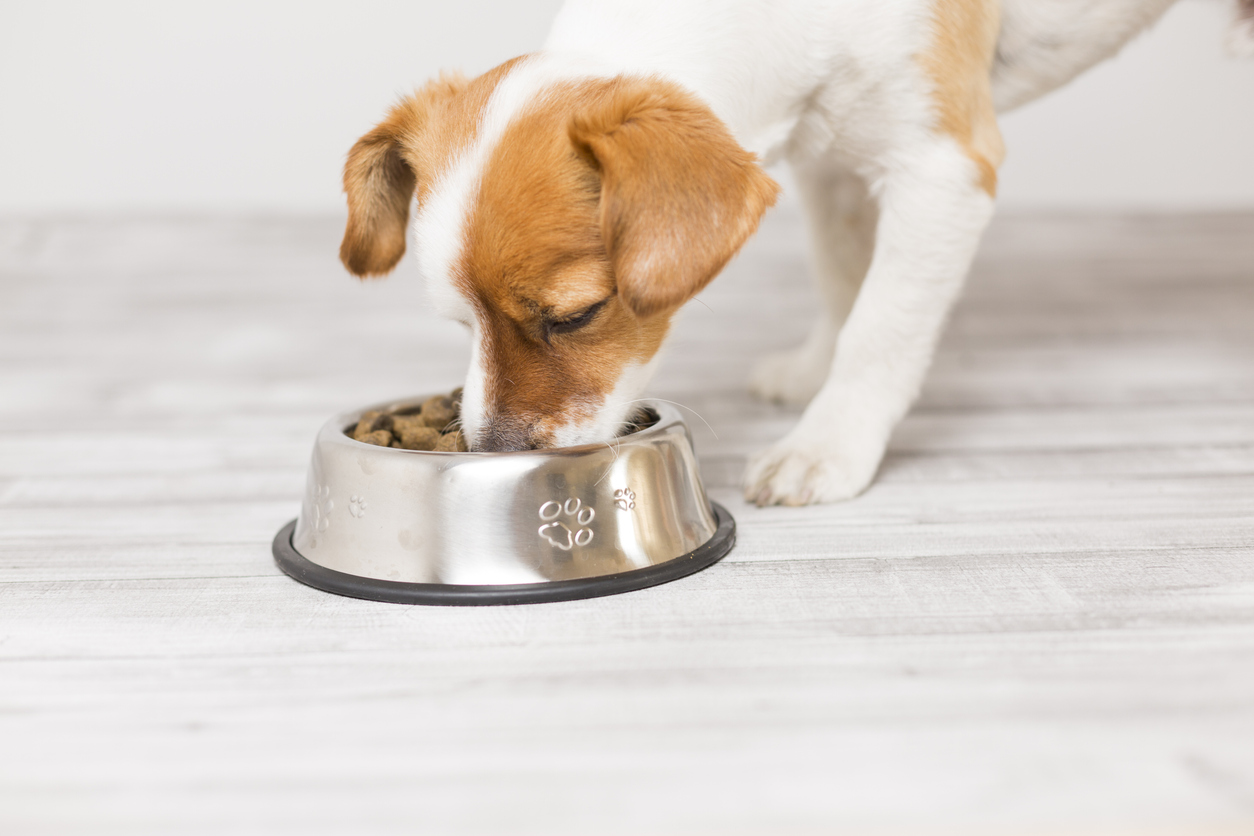What can a puppy eat? Tips for puppy feeding

Have you ever found yourself wondering ”what can a puppy eat?”. If you are a pet parent, chances are you probably have asked your vet this question several times already. However, it is important to emphasise that there is no right or wrong answer here, since each puppy is different. Numerous factors come into play when choosing the best diet for your puppy: the age, the breed, the gender if the puppy has been sterilized or not, body condition, activity levels, food preference, veterinary dietary recommendations, environment and so on; not to mention the owner’s budget and feeding philosophies.
It is however important to mention that a healthy diet can prolong life expectancy and elevate its quality in dogs. Nevertheless, dietary and nutritional recommendations are often neglected. If you are thinking how to keep your puppy healthy, look no further! In this article, we tell you what your puppy can eat.
What can a puppy eat? First-year timeline
Neonatal period (first 2 weeks of their lives)
The newborn puppy stage lasts two weeks after birth. This is a critical period for newborn puppies, as during this time, puppies are more vulnerable to infections, developing congenital defects and malnutrition. .
During this period, they are physiologically immature and dependent on their mother, needing to latch on to her for breastfeeding and receive her milk. During the first 24–72 hours after birth, the mother’s milk is incredibly important, since it is rich in nutrients, growth factors, digestive enzymes and most importantly maternal antibodies. So, what can a puppy eat in the unfortunate event they lost their mother? We suggested bottle feeding with a canine milk replacer, recommended by your vet, until the puppy can start to eat semi-solid foods.
Weaning period (3-4 weeks)
During the first phase of the weaning period (3-4 weeks of age), puppies start to eat semi-solid foods. Cow and goat’s milk should be avoided as their high lactose level might result in diarrhea and stomach aches.
Home-prepared weaning formulas are not recommended. This is because most of them are imbalanced from a nutritional standpoint, which can lead the puppy to malnutrition. Instead, we propose that you seek the advice of a veterinary nutritionist, making sure you pay great attention to your puppy’s balanced diet during this period of their lives.
Weaning period (6 weeks)
In this phase, puppies start to eat normally. After weaning and during the first 5 months of their lives, puppies should gain 2-4 g/day/kg, based on their breed. The growth rate slows down at around 6 months.
How often should I feed my puppy?
That depends on the age of your puppy:
Neonatal period: your puppy needs a lot of food right now! They should be nursed at least 4–6 times per day. The bitch’s milk supports her babies’ normal growth until approximately 4 weeks of age, during which supplemental feeding is only necessary with unusually large litters or maternal rejection.
Weaning period (3-4 weeks): during this phase, your puppy can eat fresh semi-solid food several times per day; but make sure you remove it after 20–30 minutes to prevent bacterial growth and subsequent food poisoning!
Weaning period (6 weeks): puppies should be fed at least twice daily; some of them may need three or more meals based on their daily activity.
What can a puppy eat? Allowed and forbidden foods
There are three main ways in which us, as pet parents, can choose to feed our puppies: the first one is called free-choice (self-feeding), then time-restricted or portion-controlled. In puppies (especially large breed dogs) portion-controlled feeding is the recommended regiment as it minimizes diet-related obesity and skeletal disorders associated with overfeeding.
It is important to note that some human foods are toxic for dogs, and as such should be avoided for puppies:
raisins and grapes (kidney damage)
chocolate
liver (vitamin A toxicity)
macadamia nuts (weakness, depression, vomiting)
onions and garlic (red blood cells damage and anemia)
avocados (respiratory problems)
high fat foodstuff such as chicken skin (pancreatitis)
sugar-free foods containing xylitol (liver toxicity)
broccoli (poorly documented toxicity in dogs).¹
What should puppy food contain? The 6 classifications of nutrients
Before diving further into the topic, we would like to remind all pet parents to seek professional advice from a vet or a nutritional expert before feeding their puppy any particular food, for example, eggs. This is because every dog is different, some have allergies or intolerances, which also depend on their breed, and you want to cater to their needs before deciding what diet is best for them. So, remember to always seek professional advice!
Going back to your puppy’s and nutritional needs, water, protein, fat, carbohydrates, vitamins, and minerals are the six necessary nutritional components.
Water
Clean, fresh water should be available to puppies at all times. In terms of the water found in dog foods, here is the percentage you can find based on the type of food you are feeding your dog: canned pet foods contain 60-87%, dry pet foods contain 3-11% and semi-moist foods contain 25–35%.
Protein
Another necessary component of your puppy’s diet is proteins. Proteins can be supplemented from commercial dog foods formulated with a mixture of plant and animal-based proteins that are 75%–90% digestible. Puppies need protein to sustain their growth and, especially, to build up their muscles.
Egg has the highest biological protein value, followed by animal-based proteins and plant-based proteins, respectively. Growing puppies need a minimum of 22% protein in their diet.
Fat
Fat is the main source of energy and is essential for the absorption, storage, and transport of fat-soluble vitamins (A, D, E, and K). Growing puppies should receive a minimum of 8% of fats in their diet, or they should eat a pretty good amount (5.9 g of fat per kg metabolic body weight) per day in their diet.
Carbohydrates
Carbohydrates are the second source of energy and can be supplemented from sugars, starches, and dietary fibres, such as whole grain products, in pet foods. Most carbohydrates are well tolerated by puppies, but bear in mind that highly fermentable fibres and low-cooked starches may cause flatulence, diarrhea and cramping.
Vitamins
Vitamins can be adequately supplemented from most of the commercial dog foods, however should be balanced as overconsumption of some vitamins (A and D) results in toxic reactions. There is no dietary requirement for vitamins C and K for dogs. You can ensure that your dog eats all the vitamins they need by first of all making sure to provide them with a balanced diet.
Minerals
Finally, minerals include sodium, potassium, calcium, phosphorus, magnesium, iron, zinc, copper, iodine, fluorine, selenium, chromium and are necessary components of a balanced diet. We discourage supplementation of minerals unless requested by a veterinary since it could be detrimental to your puppy’s health.

What can a puppy eat? Types of diets
More than 92% of dogs’ daily calories are provided from pet foods which can be found four forms: dry, moist, semi-moist and raw. Complete and balanced diets are formulated to provide adequate quantities of all the nutrients required by your puppy to grow strong and healthy.
Dry foods are the most popular pet foods, containing 10% moisture and 90% dry matter. The ingredients of approximately 95% of dry foods are a mixture of grains, fats, minerals, and vitamins, fat and meat and meat byproducts, such as free-range chicken or Norwegian salmon.
Moist foods (also called canned foods) contain 60%–87% moisture and 20%–30% dry matter. The ingredients are similar to the ones described above for the dry foods. They contain high amounts of both animal-based proteins such as meat products/byproducts and plant-based proteins such as grains, wheat or soy.
Semi-moist foods contain 15%–35% moisture and 55%–70% dry matter with simple sugars and salts. They are not as popular as the other two types, however some pet parents use them. These products should not be used in dogs with diabetes or insulin issues.
Raw foods (also called bones and raw food or “BARF”, biologically appropriate raw food) are another common way to feed your puppy and they marketed in two forms: home-prepared foods and commercial raw food diets.
Home-prepared foods include fresh, frozen or freeze-dried raw food. Commercial raw food are most commonly fresh, frozen, pasteurized, or freeze-dried diets combined with raw meat by some owners to provide a mix supplement.
Treats and snacks
Treats and snacks are also considered raw foods and are included in the list of things a puppy can eat. 57% of dogs receive a treat at least once daily, but they should not exceed 10% of total daily calories. High-fat and calorie dense treats and snacks should be avoided as they cause gastrointestinal problems and pancreatitis.
Nature’s Variety’s snacks are prepared with natural ingredients and healthy superfoods. They are great complementary pet food snacks also low in calories with a great flavour.
Home-prepared diets
Home-prepared diets are also called “natural”, “organic” or “vegetarian” and do not meet the nutritional demands of puppies. The recipes should be formulated by a veterinary nutritionist to ensure they meet all the nutritional demands of growing puppies and prevent food allergies and adverse reactions.
Important note: raw food diets, especially meat products, are strongly discouraged as they might contain pathogens leading to fatal food-borne diseases, such as salmonellosis.
Sometimes, the importance of diets for puppies and adult dogs is still neglected. Not knowing what puppies can eat can possibly lead to food-related gastrointestinal problems. Regimens and well-balanced diets are of the utmost importance for growing puppies to meet their nutritional demands and prevent diet-related issues. Make sure to seek the advice of a veterinary nutritionist to formulate a good and balanced food regimen for your puppy during all life stages to prevent potential issues later in life brought by malnutrition. .
